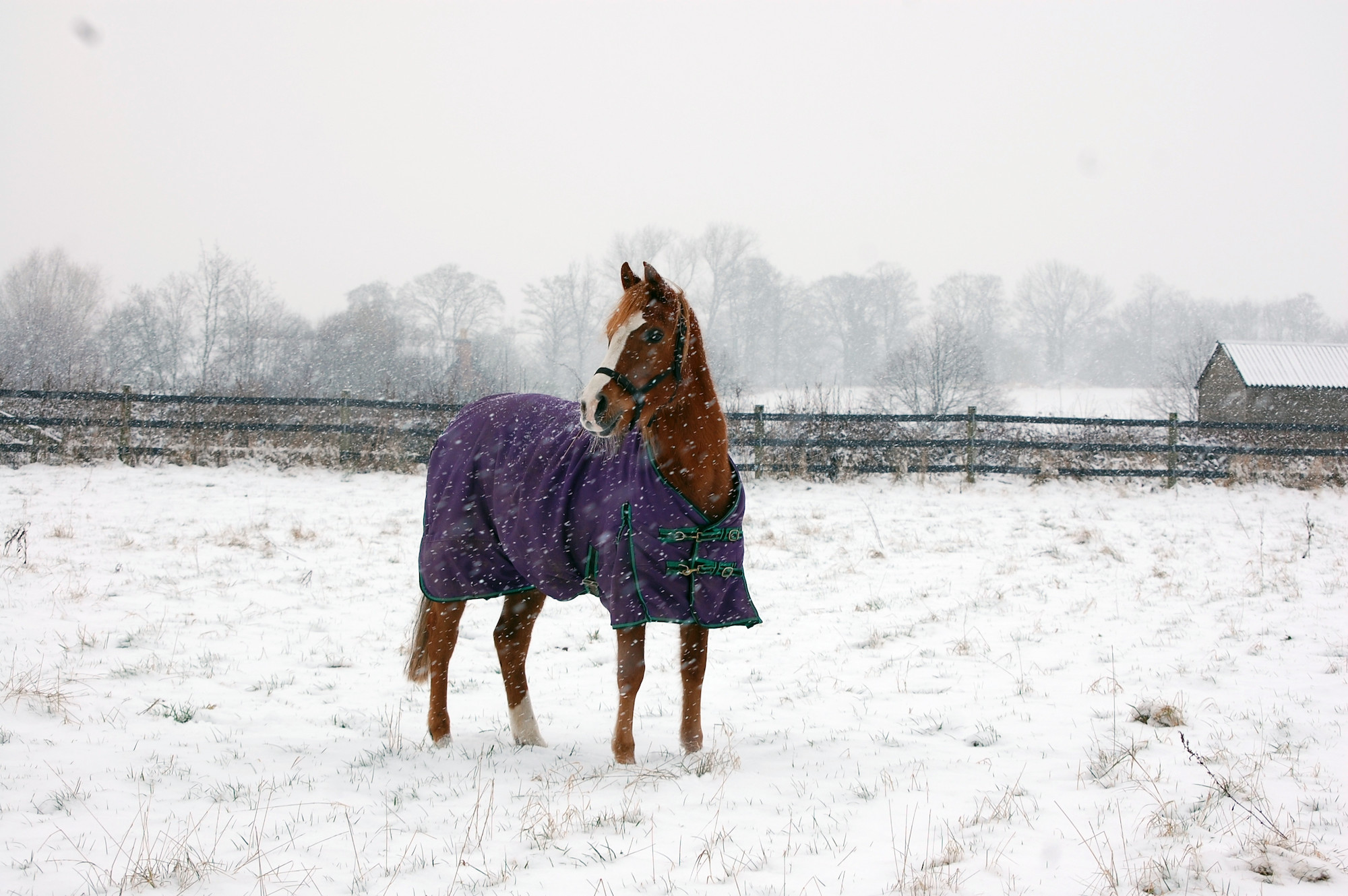
Caring for your horse in winter
Most horses cope well in cold weather, but you may need to consider additional care depending on their age, breed, condition and routine care.
Horses are designed to live out and can regulate their temperature well in cold temperatures as long as they have appropriate shelter. Some horses, like very young, elderly or thoroughbred horses, might need support like rugs and additional feed, so always consider your horse's individual needs.
When is it too cold for horses?
Horses do not feel the cold in the same way as we do. With a natural coat, they can regulate their own temperature and usually cope with temperatures between five and 25 degrees Celsius very well before they start getting cold.
We tend to over-rug because we think that when we start to feel cold, our horses must be too, but that’s not the case.
Daily checks
As with any time of year, it's important that you check on your horse regularly and know what to check. Checking their coat for rubbing if wearing a rug, for changes in weight and signs of mud fever are particularly important in winter months.
Signs your horse might be cold
- More lethargic or tired than usual
- Tucked stance, with their head lowered and turned away from the wind
- Cold to touch over shoulders (neck, withers and body under a rug)
- A reduced appetite
- Changes in behaviour such as seeming unhappy or depressed
- Extreme shivering
- Colic
Note
When checking if your horse is cold to the touch, make sure you feel right next to the skin. Winter coats are usually dry and warm next to the skin even if the outer fur is wet.
Checking for changes in weight
It's natural for horses to lose a little weight over winter compared to the warmer months. This does not mean you should automatically give them more feed. If they are dropping a significant amount of weight, it may be an indication that they're not able to regulate their own temperature or have developed a health condition. Speak to your vet for advice on what's normal.
The easiest way of keeping track of your horse's weight is by regularly using a weight tape and tracking their body score.
Feeding in winter
One of the ways horses will keep themselves warm is by grazing more. By digesting the fibre in their diet horses generate heat for themselves. As with other times of year, access to forage – such as good pasture and hay – should always be available, but most horses will not need supplementary feed.
Your horse might also benefit from a supplement of feed balancer – speak to your vet or an equine nutritionist for more advice.
If fields are frosty or frozen, grass is warmed up in the mouth and swallowed, making it safe for your horse to eat. If there is less pasture, hay should be put out. Make sure that you have more piles of hay than horses to avoid squabbling.
Note
The cold weather (below 5 degrees Celsius) can cause more sugar to be stored in grass, so you may need to limit grazing if your horse has, or is prone to, laminitis.
Supplementary feed
It’s natural for horses to lose some weight over winter as grass quality reduces and they use body fat to maintain warmth.
Very young, very old or thoroughbred horses may need feed specific to their needs, eg veteran feeds. Horses in work are likely to need an additional hard feed according to what they do to maintain their energy levels, in addition to their primary source of food - hay or haylage.
Note
Avoid sudden changes in your horses routine or feed as this can cause more issues. Introduce any changes slowly over a few weeks and speak to your vet about the best feed for your horse if you're concerned.
Watering horses in winter
It's extremely important for horses to have a constant supply of water and to check it's not frozen. Placing drinking buckets in tyres and stuffing the tyres with hay can slow down how quickly water freezes. ‘But beware, some horses might be inquisitive enough to find and eat the hay.
Popping a ball in a trough or bucket can help stop freezing and always keep a tool to break up ice handy. If water is frozen, make sure you remove any ice rather than just breaking it up.
If you use automatic drinkers, these can freeze more easily. Instead switch them off so pipes do not burst and provide water in buckets.
Horses tend to drink less in winter which increases their risk of impaction colic, so checking their water supply regularly, making sure there are multiple sources for water and putting out warmer water which takes longer to freeze can all help ensure your horse is drinking enough.
Rugs in winter
Horses' coats will get thicker during the colder months, so it's not always necessary to rug your horse. In fact, horses will keep themselves warm by eating a little more, keeping on the move, reducing blood flow to their limbs and shivering.
Horses that may benefit from a rug in winter include:
- thoroughbred and Arab horses
- fully clipped horses
- very old, ill, arthritic or underweight horses
If your horse requires a rug, look at a suitable weight for their circumstances. Remove rugs every day so they can be readjusted. You might find that a rain sheet in wet weather is enough.
Research shows that rather than keeping horses warm, over-rugging can cause your horse to become hot, sweaty and damp, which causes infections and rug rub. And it can be easy to do as we tend to think about the cold in relation to ourselves, rather than how horses deal with the cold. If you do rug your horse, regularly check whether they're too warm.
Signs your horse might be too hot under a rug
- Sweaty or moist to touch under their rug
- Changes in behaviour such as being restless or seeming unhappy
- Kicking at rugs
- Biting at rugs
- Rubbing against objects
- Rolling
- A reduced appetite
- An increased respiratory rate
Safety and environment
Shelter is extremely important in all conditions, but particularly in cold, wet and windy ones. Checking your field shelters during your daily checks is a must. Your horses may also benefit from additional wind breaks - purpose-built or rows of hedges and trees. There should be enough for all your horses.
If you’re moving your horse to new grazing, do it first thing in the morning so they become familiar with the new space while it’s light. Move your horse around to avoid churn (muddy areas) and avoid placing water and feed in the worst areas.
Safety in icy conditions is a must. Sand and grit should be available for when you need it.
When grazing is not as good, horses are more likely to forage in ditches and hedgerows for food. In the wet and muddy conditions this can be dangerous. Check your boundary fencing and hedging thoroughly every week, especially near ditches and roads. Hedges lose their foliage in the winter so might need reinforcing.
You should also check for any debris that might have blown into fields daily.
Mud fever and rain scald
Mud fever is a non-contagious skin condition caused by a bacteria that flourishes in cold and wet weather. It affects your horse's lower legs causing scabs that can lead to infection. The good news is there's plenty you can do to prevent mud fever.
- Carry out regular checks for scabs, cracked skin and swelling around your horse's hooves, heels and lower legs.
- Try to manage your pasture to avoid churn by rotating fields, feeding and watering away from any muddy areas. If you're worried an area is likely to get very muddy, you can add woodchip, mats or fence off the area, but these are usually only short term solutions.
- When you bring in your horse, wait for muddy legs to dry and brush it off instead of washing.
- Preventative barrier creams and boots are available to reduce mud sticking to your horses legs. Creams should always be applied to dry legs to avoid infection, and boots should be fitted correctly to avoid injuries. (These only tend to work with clipped legs or those that are not very hairy.)
More on the symptoms and treatment for mud fever.
Rain scald is caused by the same bacteria as mud fever, but affects your horse's neck, back and hindquarters where small painful scabs form. While it's caused by wet conditions, it can also be caused by sweat build-up when over-rugging.
- Carry out regular checks for scabs, cracked skin and swelling around your horse's neck, back and hindquarters.
- As with any time of year, make sure your horse has shelter to avoid the rain and wind.
- Regularly check whether your horse is sweaty or too warm under their rug.
- Brush out any clumps of muddy patches once dry, but avoid overgrooming as this can strip your horse of their hair's natural oils which form a barrier to the rain.
More on the symptoms and treatment for rain scald.
Important
Always speak to your vet to rule out other skin conditions like ringworm.
Snow balling
Snow can clump up and freeze to the underside of your horse's hooves, particularly if they are shoed or exercising. This can be dangerous, so applying a layer of petroleum jelly to the sole of the hoof and inside of the shoes can help avoid this.
Ensure you remove all the petroleum jelly afterwards as it can lead to nasty bacteria growing and even infection if left on once the sun comes out.
Stabling your horse
Turning out your horse as much as possible replicates their natural behaviour which is great for their wellbeing. The majority of horses will also cope very well, even in the coldest UK temperatures. Most other horses might only need a rug and extra feed to stay healthy and comfortable. Bringing your horse in overnight might be needed in fully clipped horses, lighter breeds and older horses, but they’ll still benefit from being out during the day.
In long spells of wet, cold weather, you might want to bring horses in to let them dry off completely. When you do stable your horse, make sure that their bedding is clean and dry, and they have plenty of enrichment to keep them occupied.
Riding and working horses in winter
- As with any time of year, always wear reflective clothing when you’re out riding and take a mobile phone with you for emergencies.
- Chilly winds can spook horses making them unpredictable so be extra alert when handling and riding.
- Be careful when using exercise sheets or rugs if your horse is not used to them as they can flap about in the wind.
- If it’s foggy or icy, don’t go riding – it’s not worth the risk.
- Horses can easily get chilled after a workout. Walk your horse after exercise so they can cool down slowly and, if necessary, use a cooler blanket to stop their body temperature from losing heat too quickly.
Plan for extreme weather
It's important to have contingencies in place so you're prepared for extreme snow or flooding. Would you be able to get your horse? Who would help you? Would they have the information they need?
Most yards will have plans in place, but it's worth discussing with your yard manager if you haven't already.
Page details
Reviewed
• 5 December 2023
Next review
• 4 December 2026





